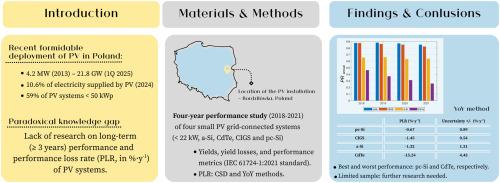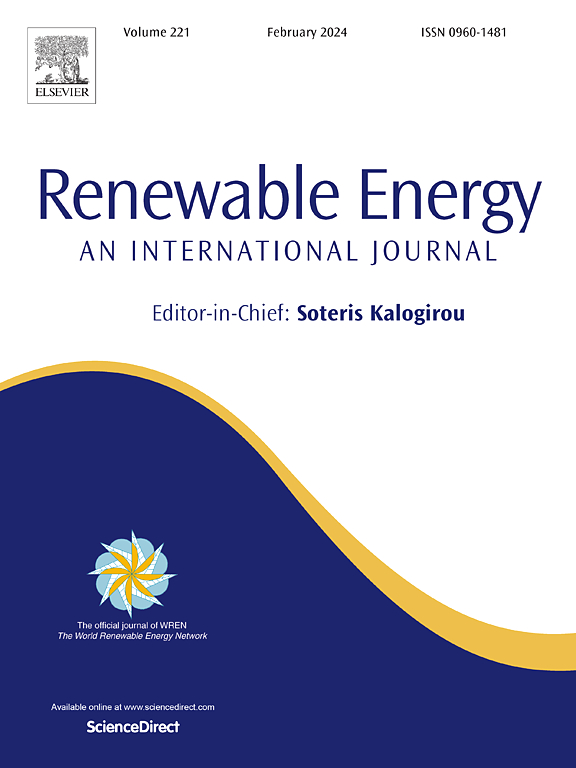A study on long-term operation and performance loss rates of various PV technologies in eastern Poland
IF 9.1
1区 工程技术
Q1 ENERGY & FUELS
引用次数: 0
Abstract
Despite Poland's rapid PV deployment, long-term system performance studies are virtually nonexistent. This paper analyzes the four-year performance of four small PV systems in Bordziłówka, eastern Poland, each using a different technology: polycrystalline silicon (pc-Si), amorphous silicon (a-Si), cadmium telluride (CdTe), and copper indium gallium selenide (CIGS). The analysis focuses on energy yields, yield losses, performance metrics and performance loss rates (PLR, in %·y−1), the latter calculated via Classical Series Decomposition and Year-on-Year methods. Pc-Si outperformed the others, with an average annual yield 2 % higher than CIGS and 25–60 % higher than a-Si and CdTe. Performance ratio (PR) values ranged from 0.88 to 0.85 for pc-Si and 0.87–0.82 for CIGS, while a-Si and CdTe showed lower PR (0.66–0.63 and 0.46–0.26, respectively). CdTe exhibited the highest degradation with PLR of −15.2 ± 4.45 %·y−1 (YoY), contrasting with pc-Si's PLR −0.67 ± 0.89 %·y−1 (YoY), which aligns with warranty standards and global literature.
Although based on a limited sample, the results offer valuable insights for PV deployment not only for Poland, but for cold-temperate climates, with relevance to Eastern Europe, Central Asia, and northern North America. The study highlights the importance of long-term, region-specific monitoring to guide technology selection and energy policy.

波兰东部各种光伏技术的长期运行和性能损失率研究
尽管波兰的光伏发电部署迅速,但长期的系统性能研究几乎不存在。本文分析了波兰东部Bordziłówka四个小型光伏系统的四年性能,每个系统使用不同的技术:多晶硅(pc-Si),非晶硅(a- si),碲化镉(CdTe)和铜铟硒化镓(CIGS)。分析的重点是能源产量、产量损失、性能指标和性能损失率(PLR,单位为%·y−1),后者通过经典序列分解和年同比方法计算。Pc-Si表现优异,平均年收益率比CIGS高2%,比a-Si和CdTe高25 - 60%。pc-Si的性能比(PR)为0.88 ~ 0.85,CIGS为0.87 ~ 0.82,而a-Si和CdTe的PR较低,分别为0.66 ~ 0.63和0.46 ~ 0.26。CdTe表现出最高的降解率,其PLR为- 15.2±4.45%·y−1 (YoY),而pc-Si的PLR为- 0.67±0.89%·y−1 (YoY),这与保修标准和全球文献一致。虽然基于有限的样本,但研究结果不仅为波兰的光伏部署提供了有价值的见解,而且还为东欧、中亚和北美北部的寒温带气候提供了宝贵的见解。这项研究强调了长期的、针对特定地区的监测对指导技术选择和能源政策的重要性。
本文章由计算机程序翻译,如有差异,请以英文原文为准。
求助全文
约1分钟内获得全文
求助全文
来源期刊

Renewable Energy
工程技术-能源与燃料
CiteScore
18.40
自引率
9.20%
发文量
1955
审稿时长
6.6 months
期刊介绍:
Renewable Energy journal is dedicated to advancing knowledge and disseminating insights on various topics and technologies within renewable energy systems and components. Our mission is to support researchers, engineers, economists, manufacturers, NGOs, associations, and societies in staying updated on new developments in their respective fields and applying alternative energy solutions to current practices.
As an international, multidisciplinary journal in renewable energy engineering and research, we strive to be a premier peer-reviewed platform and a trusted source of original research and reviews in the field of renewable energy. Join us in our endeavor to drive innovation and progress in sustainable energy solutions.
 求助内容:
求助内容: 应助结果提醒方式:
应助结果提醒方式:


